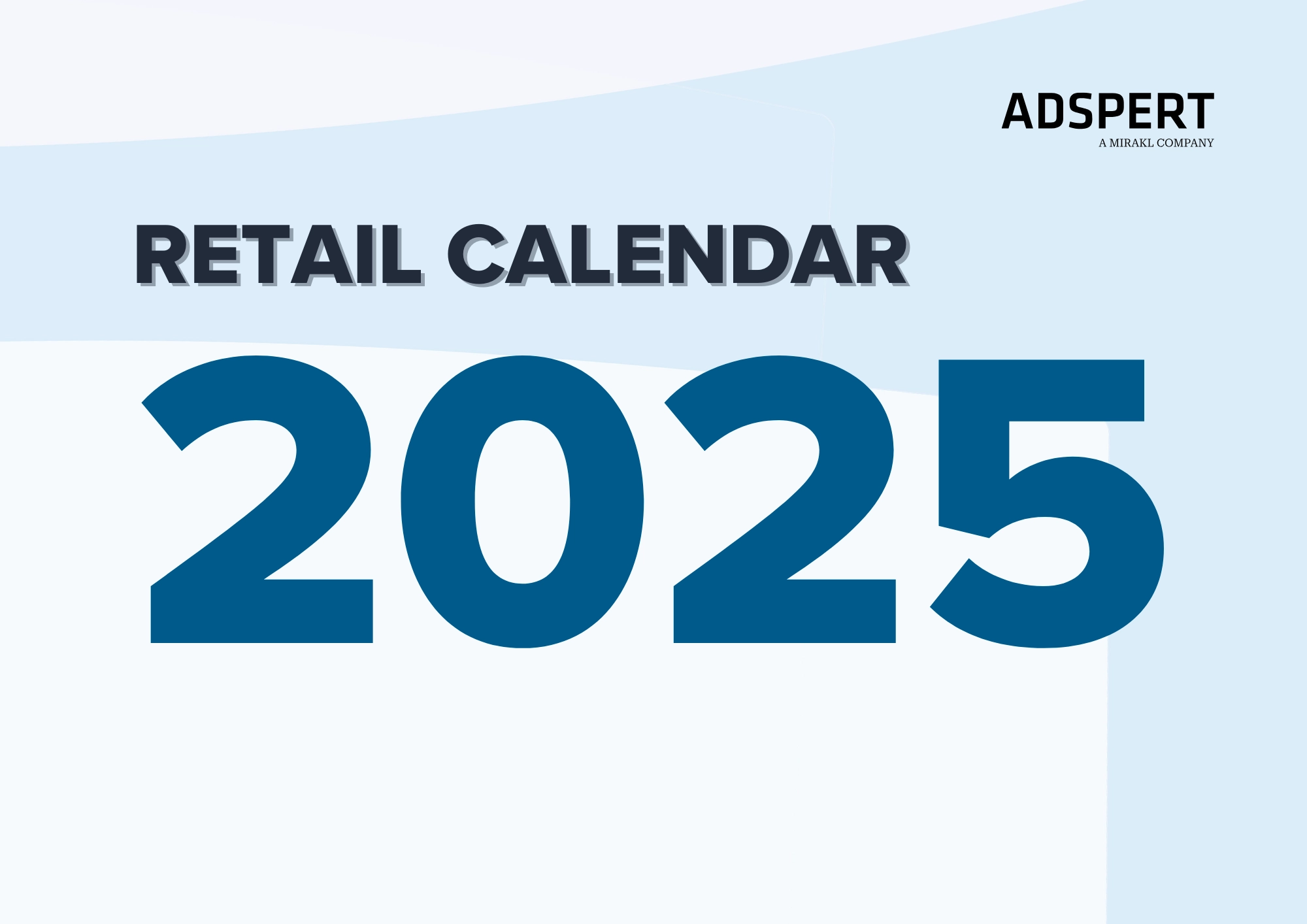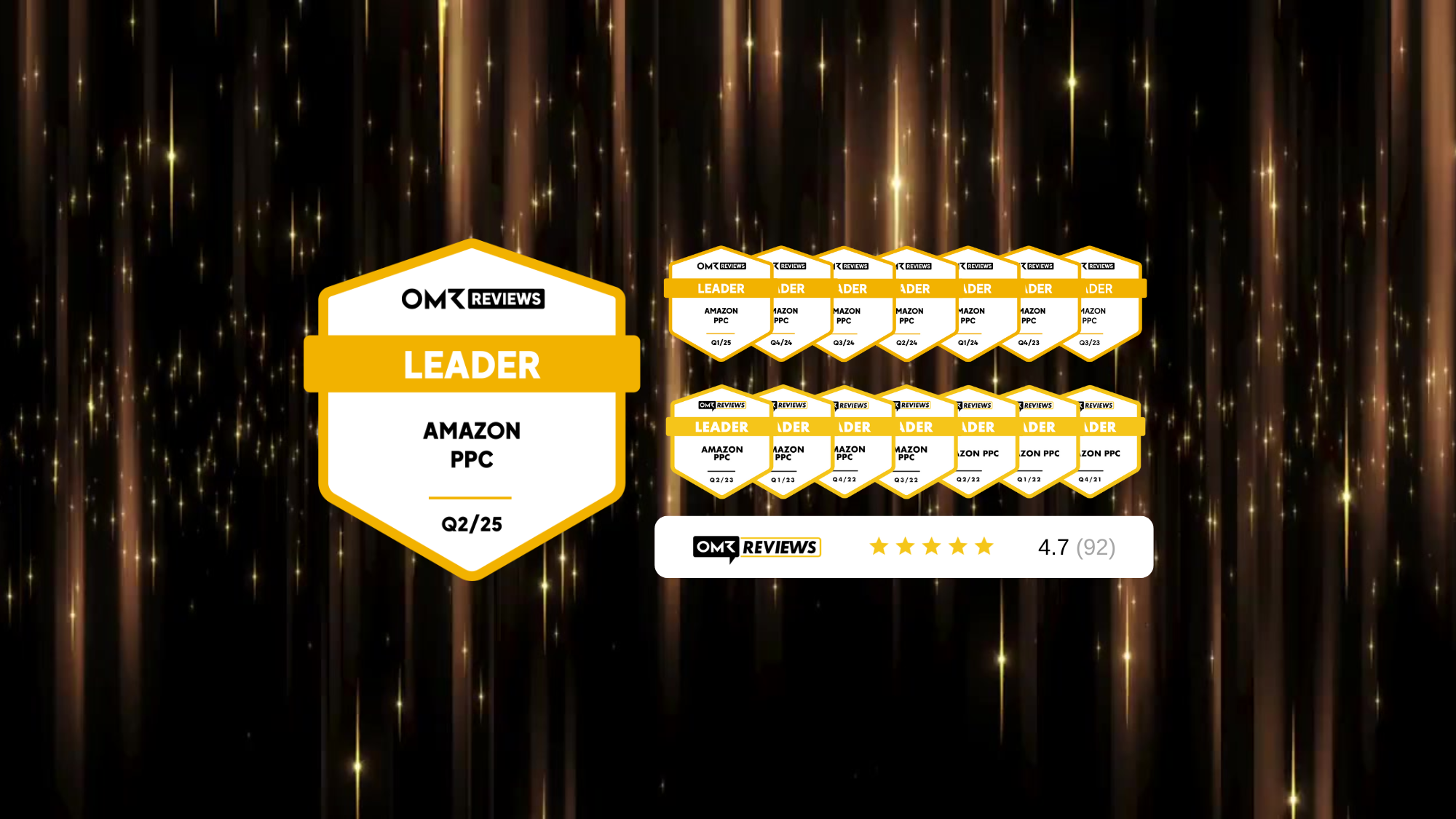This ultimate guide to Amazon PPC optimization covers the basics of pay-per-click advertising on Amazon, including campaign types and setup tips.
I will share optimization tricks and tell you how can you save your time AND money.
But before we dive into the optimization, we need to cover the basics. After all, a solid base is a foundation of success!
Amazon PPC Basics
If you are an Amazon seller or vendor (or thinking about becoming one) you must be wondering: how can I grow my sales?
With Amazon Ads! This can be an extensive and complex topic.
But if you understand the fundamentals and follow some basic guidelines, you can quickly get a great return on your Amazon Ads investment and become an expert.
And I’ll cover the basics for you in the following chapter.
What is Amazon PPC?
Amazon PPC is also known as Amazon Ads, an advertising program for Amazon’s e-commerce platform. The platform lets you advertise your products directly in Amazon stores and across Amazon’s devices.
The abbreviation PPC stands for Pay Per Click. It means that you only pay for ads when users click on them.

PPC is an auction-style bidding system. Amazon sellers bid on different keywords and highest bids on relevant keywords win the auction.
With the help of Amazon advertising, you can advertise your products on Amazon to a specific target group based on specific keywords or product attributes. Users search through Amazon store by typing in different keywords into the Search box. If their search queries match the keywords you are bidding on, your ad pops up in the Amazon search results.
Amazon Advertising for Amazon Sellers and Vendors
Amazon advertising works for Amazon sellers and vendors alike.
- Amazon Seller: sells products via Amazon and act as a retailer to the end customer.
- Amazon Vendor: delivers your goods to Amazon. Amazon handles storage, sales and delivery of your products to end customers. Vendors are not in direct contact with customers.
Whether you are a seller or a vendor, you can access Amazon advertising campaigns through Amazon Seller Central or Amazon Vendor Central.
Read on to learn how each of them works and when to use which campaign type.
Mini Amazon Ads Glossary
I’m not going to lie: Amazon Ads world is extensive and therefore confusing to a lot of people.
All of a sudden you find yourself in a PPC world filled with terms and expression you’re not familiar with.
That’s why I put together a mini Amazon Ads glossary. Here you can find short and quick explanations of key expressions:
- ASIN
- Keywords
- Negative Keywords
- Keyword match types
- Targeting
- Bid
- Daily budget
- Product attribute targeting
- Audience remarketing
ASIN
ASIN is an Amazon term that stands for Amazon Standard Identification Number. This is a unique number given to every product sold on Amazon.
ASIN consists of ten digits and helps Amazon keep track of its near-limitless inventory.
Keywords
Keywords are key phrases that can trigger an ad to appear on Amazon.
With pay-per-click advertising, you select keywords and then bid on them with your advertising campaigns.
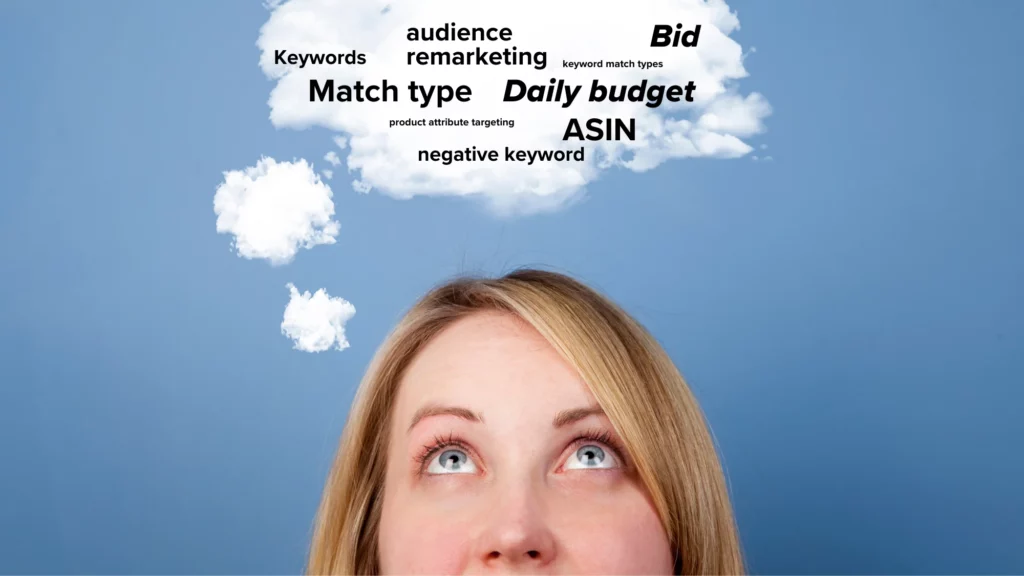
Negative Keywords
This is a list of keywords for which no ads should be displayed. By using negative keywords you can use your budget even more effectively.
Keyword Match Types
There are three match types within Amazon Ads:
- Exact match: your selected keyword must exactly match the user’s search query for your ad to be displayed.
- Phrase match: your selected keyword triggers your ad when the user’s search query includes either an exact match or its close variation.
- Broad match: your selected keyword triggers your ad when the user’s search query is similar to your keyword. Or if Amazon’s search algorithm detects it is somewhat relevant.
Amazon PPC Targeting Options
There are several different types of targeting.
Keyword targeting
Keyword targeting refers to keywords that you use to describe your product listing. Then you select the most relevant keywords to target in your Amazon Ads campaigns.
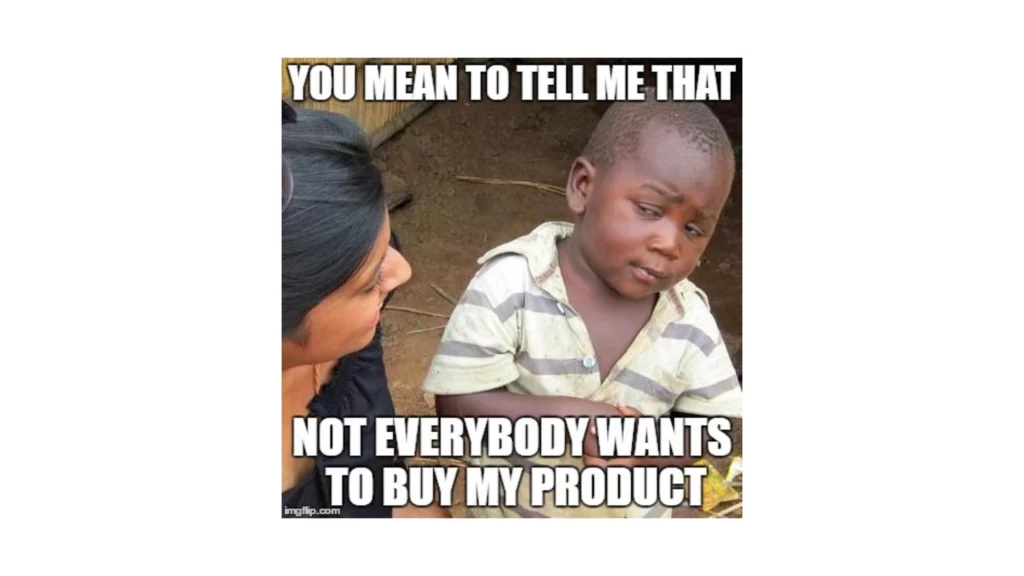
When shoppers are searching for those keywords on Amazon, ideally, your ad appears in their search results.
Product targeting
Instead of targeting keywords, you can also target products. This means when an Amazon user searches for the same or similar product on Amazon, your ad can appear in their search results.
Negative targeting
Negative targeting works exactly the opposite way. Instead of including keywords or products to your advertising campaigns, you exclude them.
When you add a negative keyword or product to your Amazon Ads platform, you tell Amazon to exclude your ads from related search results.
Retargeting
Retargeting addresses users who were interested in your products or product category on Amazon within the past 30 days, but did not buy anything.
Important note: retargeting only works with Sponsored Display Ads (one of the three Amazon Ads campaign types).
Bid
Bid is the maximum price that you are willing to pay per click on one of your Amazon ads. You can increase bids to hopefully improve your ranking options. Bids can be fixed or dynamic.
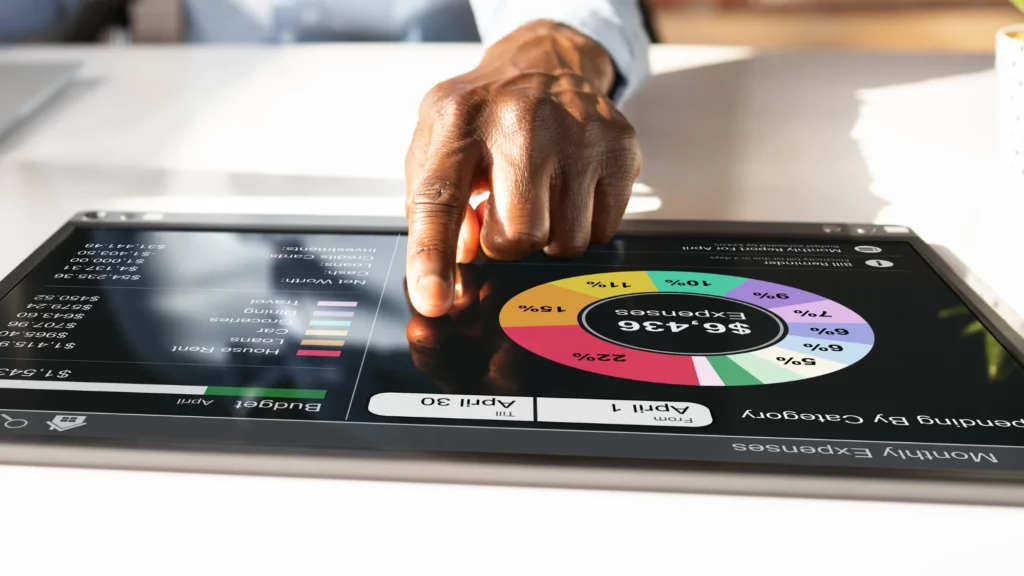
Daily Budget
Your daily ad budget is the maximum amount you want to spend on ads per day. To display Amazon ads on amazon.com, you can have a daily budget between 1 and 1,000,000 €.
Product Attribute Targeting
Do not mix up Product targeting and Product Attribute Targeting! The latter focuses on product attributes such as:
- Brand
- Price range
- Star ratings
- And more
This type of targeting is more specific and allows you to reach better-defined audiences.
Audience Remarketing
With audience remarketing, your ads are displayed to users who have shown interest in your or similar products but have not yet bought them.
Learn more about related terminology and Amazon acronyms list. This will help you gain more knowledge and confidence when it comes to the optimization.
Key Takeaway
Now you know exactly what is Amazon PPC – same as Amazon Ads. You can advertise on Amazon whether you are an Amazon seller or Amazon vendor/b.
The only difference is from where you access Amazon Ads: either through Amazon Seller Central or Amazon Vendor Central.
I also introduced basic terminology and explained what is ASIN, what are the targeting options and keyword match types (exact match, phrase match and broad match).
Let’s move on to see how Amazon PPC works before we move on to reveal how you can optimize PPC campaigns!
How Amazon PPC Works?
In a nutshell, PPC is an online advertising based on auctions, bidding, keywords and products.
Advertisers place a bid either on a product or keyword to get their item to appear at the top of Amazon search results.
The highest bid usually (but not necessarily!) wins the auction. More on that a bit later (scroll down to The Highest Bid Does Not Always Win).
Only the winner’s ad appears in the Amazon search results.
Practical Example
An Amazon shopper is searching for an item. The shopper types in a keyword related to the product. A seller or a vendor who placed the highest bid on that keyword, wins the auction.
An ad for their products pops up. If a shopper clicks on the ad (and only then!), a seller gets charged.
How Much Does Amazon PPC Cost?
PPC stands for pay-per-click. First: you only pay for an ad if someone clicks on it. Second: you set your own daily budget, your maximum amount that you are willing to spend on Amazon Ads per day.
Essentially, you will never pay more than what you specified as your daily budget. You decide what will be your cost. When you run out of your daily ad budget, you automatically won’t take part in auctions anymore on that day.
But here’s the kicker: you can pay less. Keep reading to find out how and why.
How Is Amazon PPC Bid Calculated?
The maximum bid does not mean that the auction winner pays the exact amount. The click price for the winner is actually based on the runner-up’s bid and is just slightly higher.
Sounds confusing?
Let’s have a look at an example:
Practical Example
Seller A bids 2€. His bid is the highest.
Seller B is a runner-up with 1€ bid. His bid is second highest
Seller A is the auction winner. When a shopper clicks an ad triggered by a relevant keyword, Seller A pays 1,01€.
Essentially, this is how Amazon bidding works. The entire bidding process is automated and is happening over and over again in the background.
Every time a shopper searches on Amazon a bid auction automatically happens in split seconds and thousands of sellers and vendors keep losing or winning Amazon PPC bid auctions.
The Highest Bid Does Not Always Win
The bid amount is important, but is far from being the only criteria for ranking Amazon search results.
In other words, having the highest bid does not guarantee that your product will appear at the very top of the search results.
Why? Because with Amazon, the customer comes first.

Amazon’s ranking algorithm is complex and takes into account numerous factors.
Here are some that are related to customer service:
- Customer reviews and ratings
- On-time delivery
- Product availability
- (Free) Shipping options
- Response time to customer inquiries
Even though higher bids do not guarantee you to win the auction, they do drastically increase your chances.
When will I be charged?
A big advantage of PPC is its pay-per-click model. You only pay for actual clicks on your product or ads (with an exception of Sponsored Display campaigns, but more about that later on).
Amazon shows your ads, but you pay for them only when shoppers click on them.
Think of it this way: your ads are shown for free and even without clicks, you can get a lot of impressions.
For this reason, Amazon aims at getting you clicks and it’s good for both sides. Amazon shoppers get served the products they are looking for and sellers and vendors get to sell their products if shoppers go for them.
Key Takeaway
Amazon pay-per-click (PPC) is an online advertising system that works on auctions, bidding, keywords, and products.
You and other advertisers bid on products or keywords to have your items appear at the top of Amazon search results, and the highest bid (usally) wins the auction.
The cost of Amazon advertising is determined by your daily budget and the click price for the winner is based on the runner-up’s bid.
Is Amazon PPC Worth It?
Like anything, also Amazon advertising has its pros and cons. Whether it is worth it for you, it depends on a wide range of factors related to your business goals and circumstances.
A lot of sellers and vendors successfully use ads to sell their product faster and increase their product turnover.
9 Amazon Ads benefits
1. Increase product visibility
With the help of the Amazon advertising, you can significantly increase the chances for your products to appear at the top of the Amazon search results.
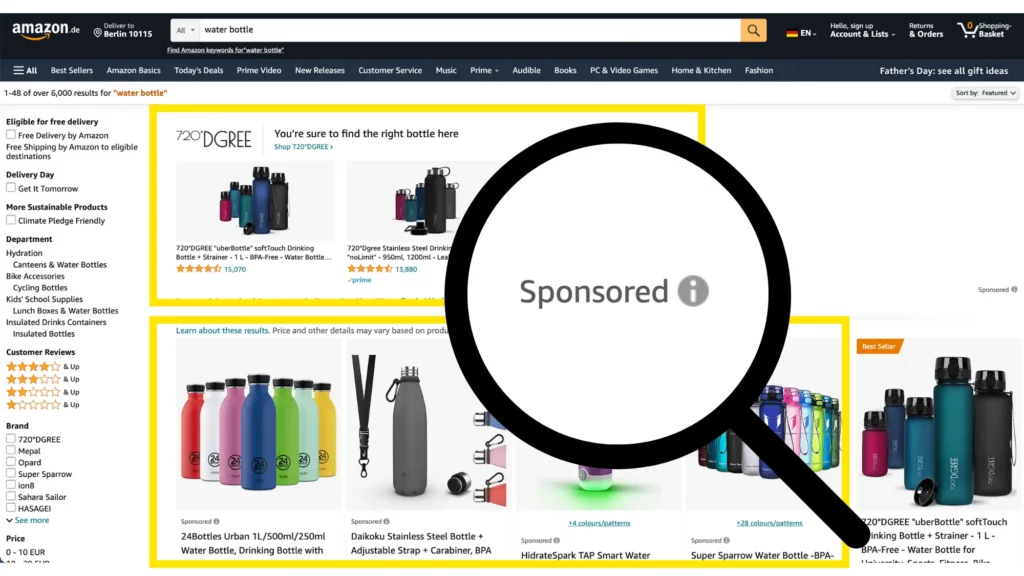
Your products will receive more attention than other listings placed lower in search results.
2. Sell more products
It doesn’t matter if you want to sell a top seller or a new niche product. With Amazon Ads and their proper optimization you can promote all products from your portfolio. Ultimately, your sales will grow!
3. Accelerate sales of seasonal products
Do you sell seasonal products? Like Christmas decorations, Valentine’s cards or Halloween costumes? With the help of Amazon Ads you can make sure to sell your products when it’s the right time.
4. Promote new products
What are the chances for new products to appear at the top of Amazon search results? Close to zero (in most cases)! With advertising campaigns, you can give your new products the boost they need.
5. Leverage top products to gain more visibility
Congratulations, some of your products made it to the top of the Amazon search results page! Now: don’t rest on your laurels. Leverage ads to maintain your product at the top and don’t let competition beat you.
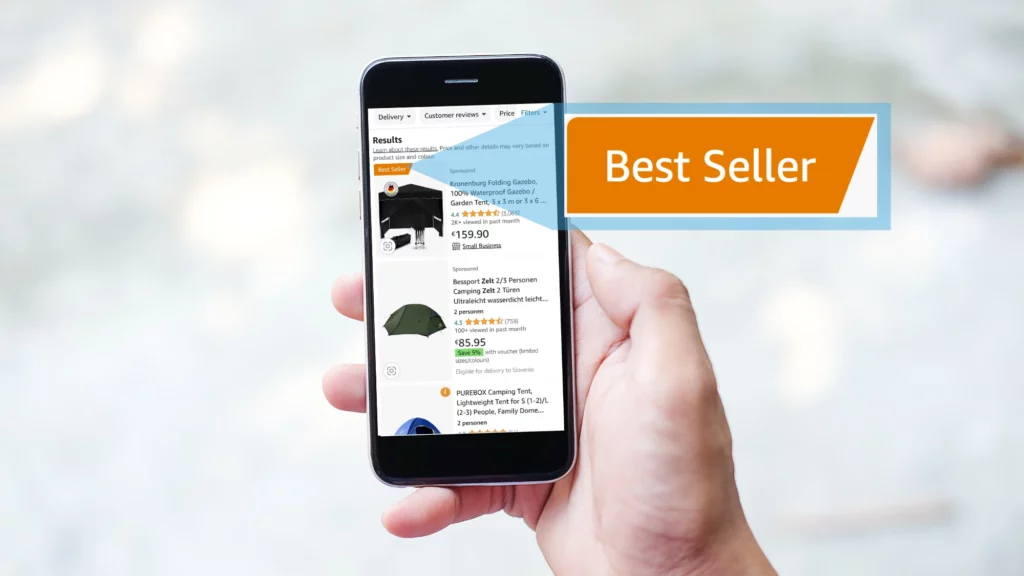
More than that, with promoting your top products you can also increase your visibility. Amazon shoppers will see your products more often. And more exposure means more clicks (and conversions – fingers crossed)!
6. Improve organic search results
It’s clear that Amazon PPC is paid, which is the opposite of organic. Here’s the interesting part: organic search results are related to paid search results.
You might find it contradictory but paid advertising also increases organic rankings! It is not a secret and a lot of Amazon sellers and vendors use Amazon Ads to improve their organic sales as well.
7. Stay ahead of your competitors
Amazon is huge and for basically anything you sell, there’s competition. Advertising is one of the ways to stay ahead of your competitors by promoting your products.
8. Boost your click-through rates
Do you have products with high margins but low click-through rates? Here’s where Amazon Ads can help you out. Set up advertising campaigns for your products to get more clicks and grow your profit margin.
9. Get rid of your leftover stock
Amazon advertising campaigns help to sell reduced products even faster. They make your target group aware of the price reduction.
Key Takeaway
If you’re not seeing the expected results, start to optimize Amazon PPC campaigns to improve your Amazon advertising performance.
Don’t worry, I have you covered – I’ll give you 5 tips on how to optimize PPC campaigns. Or scroll straight down right away.
2 Must-Haves for Winning Amazon PPC Campaigns
When you invest in running ads, you want to see a good return on your investment.
Fortunately, there’s some tips that you can use to increase the success of your Amazon Ads.
I’ll cover 2 must-haves for super effective campaigns:
- Retail-ready product listings
- Winning the Buy Box
Retail-Ready Product Listings: My 6 Favorite Tips
Tired of staring at your sales numbers and trying to figure out what else you could do to grow your sales?
Go back to the basics. Review your product listings if they are truly retail ready.
Amazon retail readiness means that a product listing is well designed and contains all information your target audience needs to make a purchase.
Retail-ready products tend to generate more sales, organic and paid.
Here are 6 components of retail ready products that also boost performance of your campaigns:
#1: High Quality Images
Visual elements play an enormously important role in everyday life: they make up about 93% of human communication. eCommerce is not an exception.
Especially with Amazon where it’s all about the customers. The better your product images, the better the idea they get about your product.
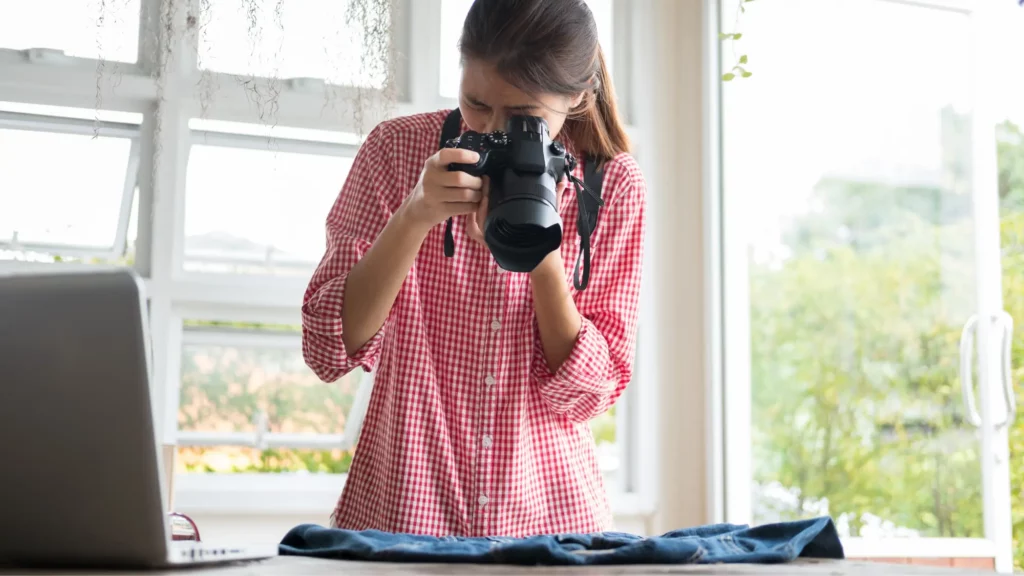
To make your product listing retail-ready, follow these image guidelines:
Do’s:
- Use only high quality images.
- Put a white background behind your main image.
- Display the whole product.
- Use all the space. Your product should fill 80-100% of the image.
- Don’t add text or graphics that aren’t a part of your product.
- Show different angles of your product, dimensions, detail shots, different colors, sizes, styles, etc.
Don’ts:
- Do not include website URLs, prices, shipping details, promotions, or watermarks to any image
- Do not display other items that are not a part of your product portfolio
#2: High Quality Text
No one likes confusing and vague descriptions! Describe your products in a clear and detailed way. Use the most relevant keywords to describe the product.
Product Title
When you are creating a product listing, the product title automatically generates based on the data you have provided. If you have thousands of products, this can save you lots of time.
But if you can set some time aside, I recommend you to spend some time creating your own, more appealing product titles.
Ideal Amazon product listing title is:
- Precise and appealing.
- Max. 80 characters long (so that it is also displayed in full on mobile devices).
- Includes information about color, size and weight.
Bullet points
Next to the product image on Amazon, there are 5 bullet points that outline the product’s main benefits and features.
- Each bullet can be 10-255 characters long.
- Use product-related keywords.
- Do not write full sentences.
- Do not use exclamation marks or superlatives such as “best”.
- Do not include hyperlinks.
Product Description
Product description explains the most important product features.
- Use whole sentences.
- Spell-check your text!
- Make it easy to read, use paragraphs.
- Include information about product size and specify exact dimensions
- Explain the intended use, add care instructions and warranty information.
#3: High Customer Ratings and Reviews
Positive product ratings and reviews help other users make a purchase decision. They also influence the search engine optimization (SEO) of your listing and can thus promote conversions.

Only a few positive reviews are not enough. Amazon will consider your product retail ready when it has at least 15 ratings or reviews with an average of 3.5 stars or higher. Needless to say, also your Amazon PPC campaigns will be more successful.
Customer ratings on Amazon are updated in real time. Check them regularly, especially when you are running advertising campaigns.
Your product doesn’t have enough ratings or reviews? Use the Amazon Vine program to gather more customer reviews.
#4: Competitive Price
Price is a big factor from most perspectives. If your product has the lowest price in your segment, it will be much more attractive to Amazon users and Amazon Ads alike.
#5: Inventory (or Why You Should Never Run Out of Stock)
You can’t sell what you don’t have! Even worse: running out of stock can have a negative impact on your product ranking.
Products that you sell on Amazon should always be available to customers. Check your inventory regularly – especially during sales events such as Amazon Prime Day, Black Friday and Cyber Monday.
#6: Promote Your Brand with Amazon Brand Registry
If your company or your products are registered as a trademark, use the Amazon Brand Registry to register your brand.
Registering a brand with Amazon gives your brand additional protection. You can also benefit from a better presentation of your products.
How to Win the Buy Box
Winning the Buy Box gives you a big advantage over your competitors. It is literally a box with a “Buy” button that makes it easier and faster for users to purchase products (top right on desktop and below the product on mobile).
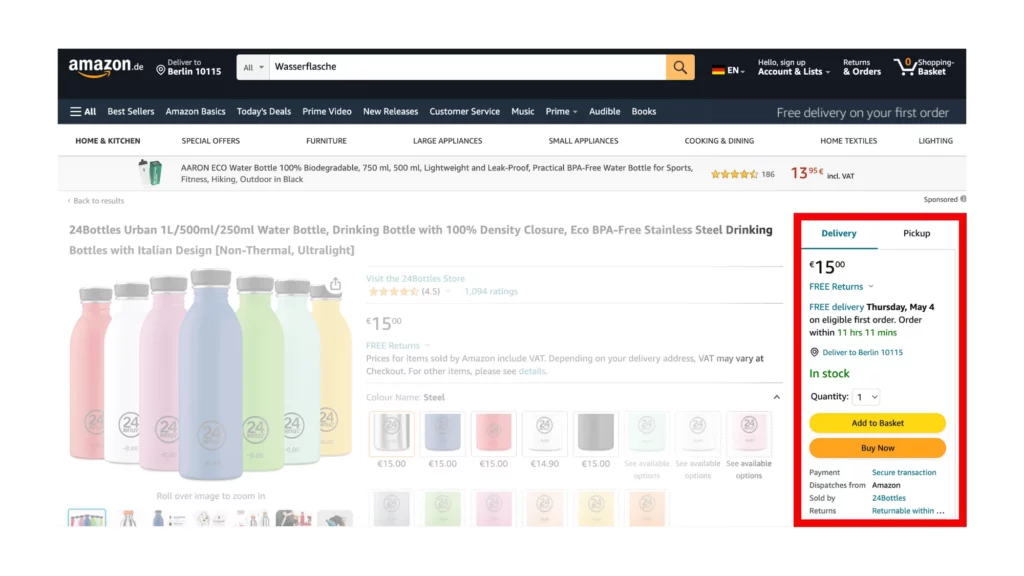
Buy Box is also a clear signal to Amazon advertising platform, that your product is the juice that is really worth the squeeze.
Amazon uses a complex algorithm to assign the Buy Box. There is no 100% correct textbook on how to win the Buy Box.
But if you follow these guidelines, you will increase your chances:
- High-quality product presentation (check if your product is retail ready)
- Low price
- Top reviews
- Fast delivery
- Low rate of order defects, returns, cancellations, late deliveries
- Short response time to customer inquiries
In a nutshell, to win the Buy Box, you need to have as many satisfied customers as possible. At the same time, keep the bounce rate low and try to avoid complaints.
Key Takeaway
Don’t cut corners when it comes to your product listings. Do everything you can to have retail ready products that are likely to win the Buy Box.
Use high-quality product title, description, images and all other supporting information. Work on getting positive reviews, keep your products well-stocked and deliver fast.
All this will help you to not only have winning campaigns, but also see high organic sales.
How to Choose Right Campaign Type to Grow Your Sales
If you want your Amazon Ads to bring you more PPC sales, you first need to pick a suitable ad campaign type.
What are the 3 types of Amazon PPC ads?
There are three different Amazon Ads campaign types:
- Sponsored Products
- Sponsored Brands
- Sponsored Display
The question is: Which one should you pick without losing money with trial and error?
Read on to find out.
Sponsored Products
Sponsored Products campaign type focuses on products and promotes their visibility. It is available to sellers and vendors and it is easy to set up.
Sponsored Products is the most popular Amazon campaign type. That’s why I also created a step-by-step tutorial on how to set up a powerful Sponsored Products campaign (scroll down).
Aim: Increase visibility
Targeting: keywords and products
Go with Sponsored Products if you would like to increase visibility of your products. Most sellers do!
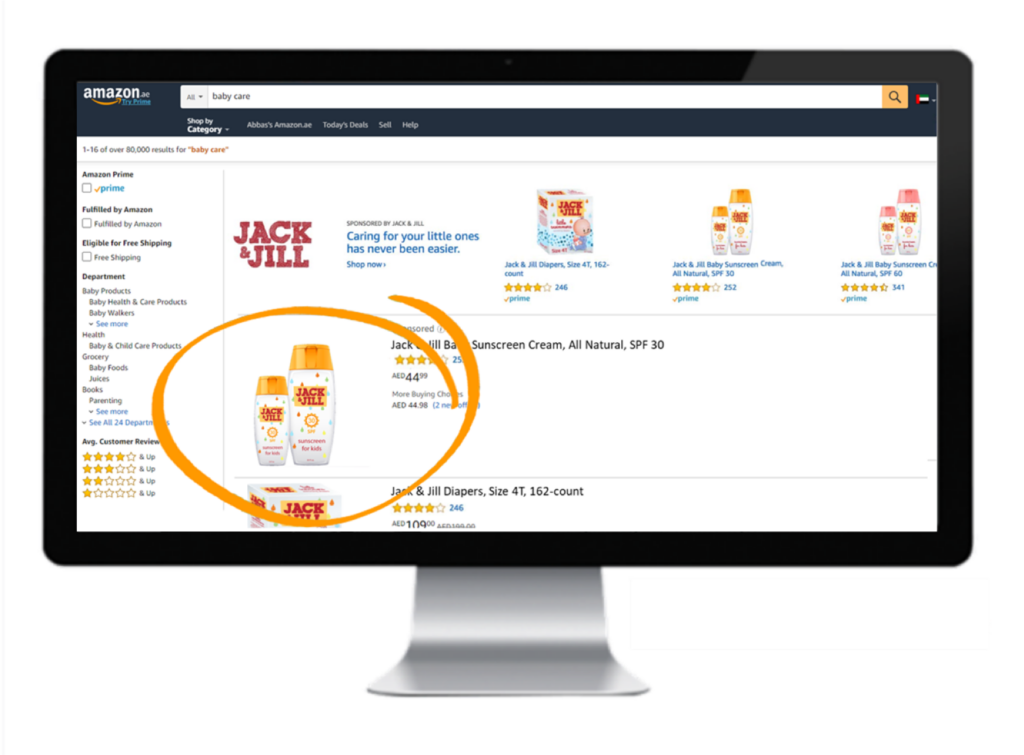
What are Sponsored Products campaigns good for?
Sponsored Products campaigns will bring more traffic to your product detail pages. They help you increase the visibility of your products and accelerate your sales.
Where are Sponsored Product ads displayed?
Sponsored Product Ads appear above, below, and next to search results:
- Above the organic search results
- Below the organic search results
- On the right side next to the search results
- On the product detail page in the carousel under product description
Depending on the search query, there can be many Sponsored Products ads stacked one on top of another.
You cannot choose the placement of your ads. Amazon scans your ads and PPC settings and then determines your ad rank.
Ad rank depends on your bid, your product performance, and bids of your competitors.
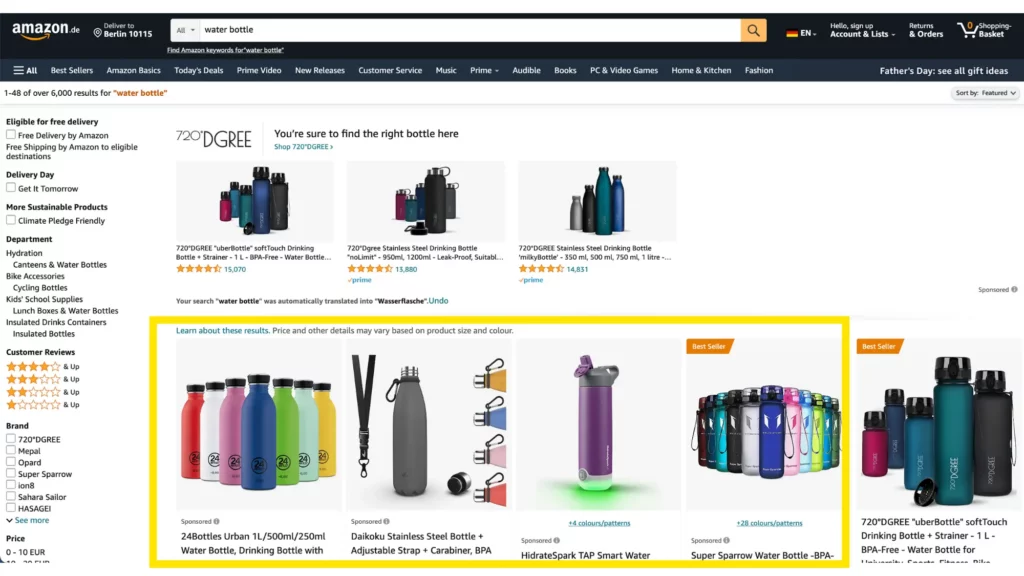
What are the targeting options?
As an Amazon seller or vendor, you can control the campaigns either via keywords or products. For product targeting, use product category or ASIN.
Which bidding options do Sponsored Products support?
Sponsored Products campaign type supports automatic and manual bidding.
I recommend you to go start with automatic campaigns to see which keywords work best for your product. Then you can level up your optimization and use those keywords in manual campaigns.
Sponsored Products bidding options:
- Auto-Campaign
- Manual campaign with a focus on keywords
- Manual campaign focused on products (PAT)
What are the benefits of Sponsored Products campaigns?
Sponsored Products ads generate scalable and qualified traffic. You can advertise your products above the search result and improve their sales.
In addition, you have all kinds of options when it comes to keyword targeting.
What are the disadvantages of Sponsored Products campaigns?
Sponsored Products campaigns don’t include the placement in the header above the search results. This space is reserved only for Sponsored Brand ads.
Sponsored Brands
Sponsored Brands campaign type helps Amazon customers discover and engage with your brand. These advertising campaigns generate brand awareness and link to your landing page or your Amazon store.
Aim: build brand awareness
Targeting: keyword and products
Condition: register your brand in Amazon Brand Registry.
Sponsored Brands options:
- Sponsored Brands
- Sponsored Brands Video
If you are already registered in the Amazon Brand Registry and would like to grow your brand, go with Sponsored Ads.
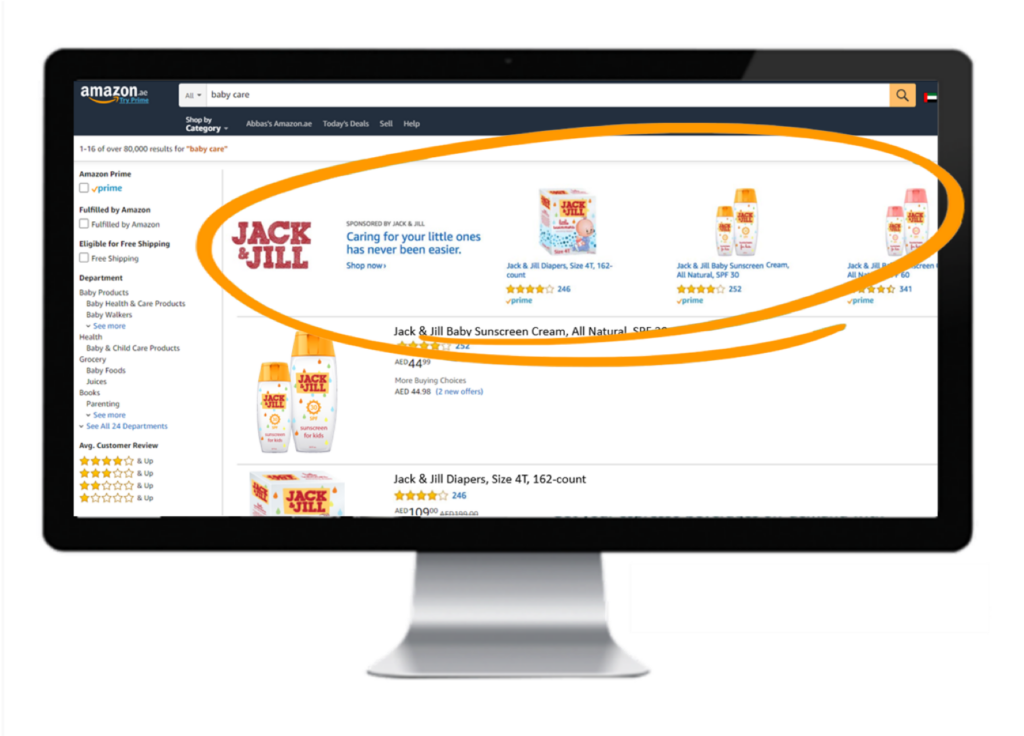
What are Sponsored Brands campaigns good for?
Sponsored Brands campaigns are great for building brand awareness. Aside from that, you can increase the visibility of your products because Sponsored Brands appear at the topmost part of the page.
The best part? If you have your Amazon store, your ads can link directly to your store and not just to individual products.
You can display up to three products in one Sponsored Brands ad at the same time. Usually sellers go for their top selling products.
Where are Sponsored Brands ads displayed?
Sponsored Brands ads appear above, below, and next to search results:
- Header above the search results
- Above the organic search results
- Below the organic search results
- On the right side next to the search results
- On the product detail page in the carousel under product description
In the Amazon mobile app, Brand ads appear above the search and in line with the search results.
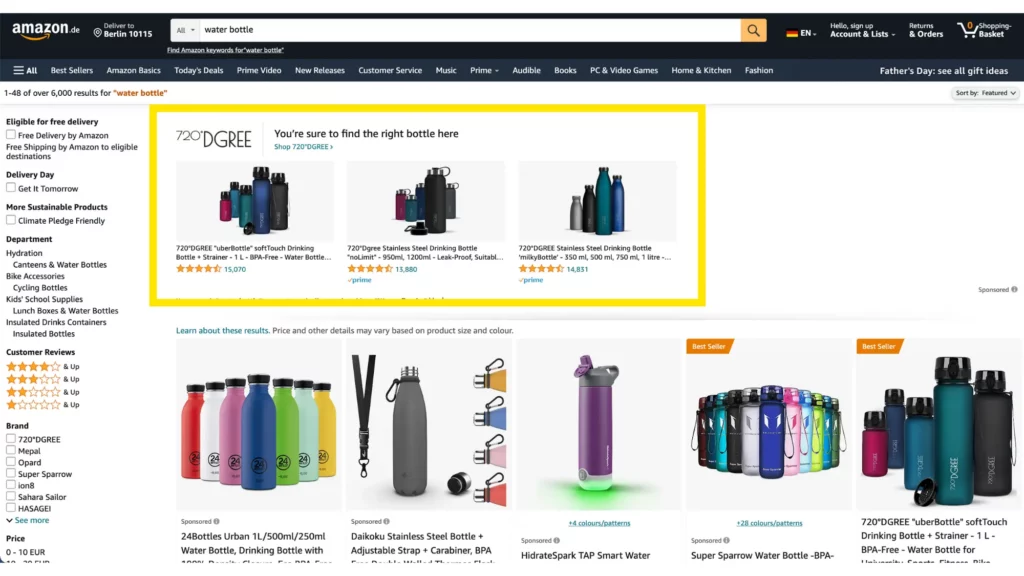
What are Sponsored Brands targeting options?
Targeting is possible at both product and keyword level. You can also add negative keywords and exclude certain products.
Which bidding options do Sponsored Brands support?
Sponsored Brands campaigns can be controlled automatically or manually (just like Sponsored Products).
I recommend you to start with automatic campaigns to see which keywords work best for your product. Then you can move on to manual campaigns and take a more granular approach to your optimization.
What are the benefits of Sponsored Brands campaigns?
With Amazon’s Sponsored Brands you can display your brand and products in the highest position on the search results page. Plus you can drive traffic to your Amazon store and not necessarily a single product listing.
You can also use customizable ads and video ads.
What are the disadvantages of Sponsored Brands campaigns?
It’s not as much a disadvantage as it is a pre-condition. Before you can use Sponsored Brands campaigns, you need to register your brand in the Amazon Brand Registry.
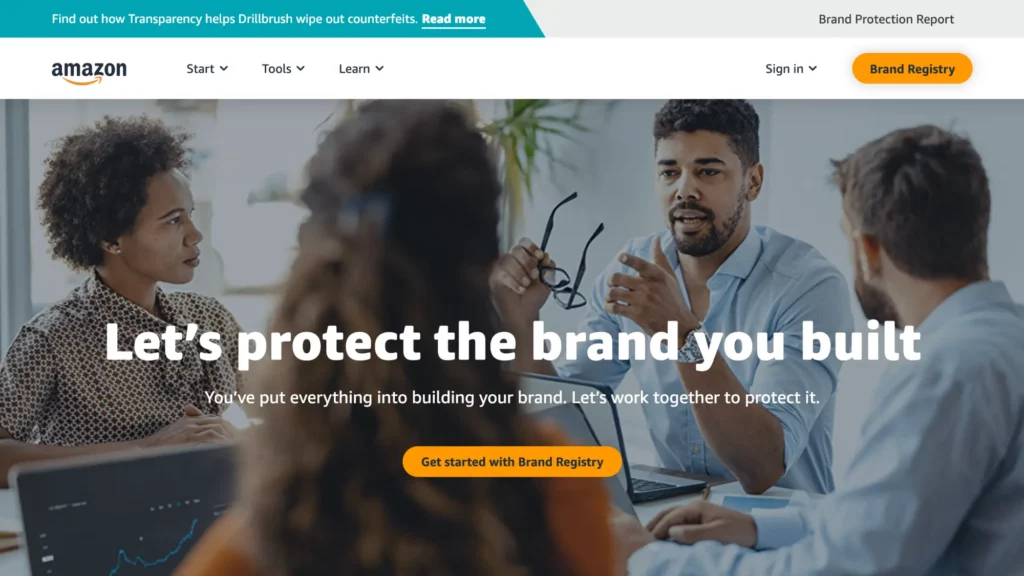
Sponsored Brands ad types
- Sponsored Brands Product Collection – display three products in one ad
- Sponsored Brands Store Spotlight – you promote your entire Amazon store
- Sponsored Brands video – arguably video can draw much more attention than static ads. The video starts playing automatically once 50% of the ad is visible.
Unlike other Amazon ads, you can design Sponsored Brands Ads yourself!
Sponsored Brands video consist of three components:
- Headline
- Brand logo
- Three products from your portfolio
Sponsored Display
With the help of Sponsored Display ads you can reach relevant audiences browsing both on and off Amazon.
These ads are displayed to users who have already shown an interest in your or similar products or relevant product groups.
After a user clicks a Sponsored Display ad, they land on your product detail page.
Aim: reach relevant audiences
Targeting: products and audience
Ad placement options: on and off Amazon
Like all other Amazon ad formats, you only pay per clicks and not for impressions.
Sponsored Display options:
- Audience
- Product
Go with Sponsored Display if you would like to reach relevant audiences on and off Amazon.
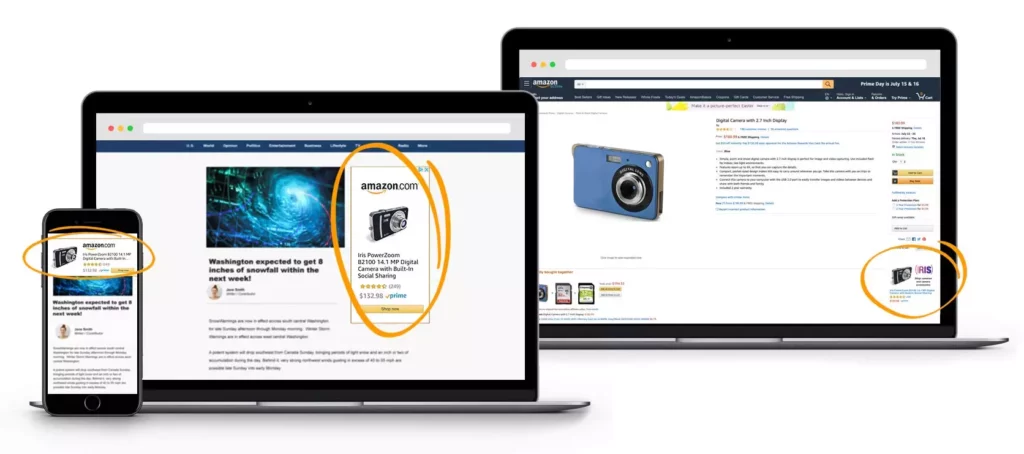
How does Sponsored Display ads look like?
Sponsored Display ads are automatically generated based on your product inventory. They have a simple structure and consist of:
- Product title
- Product image
- Price
- Ratings
- Prime shipping info (if applicable)
What are Sponsored Display campaigns good for?
Sponsored Display advertising campaigns are a go-to option for:
- Reaching relevant audiences
- Remarketing
- Retargeting
What is special about this campaign type is that the ads are not controlled by keywords, but by the relevance of the advertised products based on previous user behavior.
Where are Sponsored Display Ads displayed?
Sponsored Display ads are shown within and beyond Amazon ecommerce platform to increase your reach:
- Sidebar of the product details page
- Under the Buy Box
- Below the search results
- In between customer reviews
- On external websites and apps
- Special feature: Sponsored Display ads can also be integrated into follow-up emails.
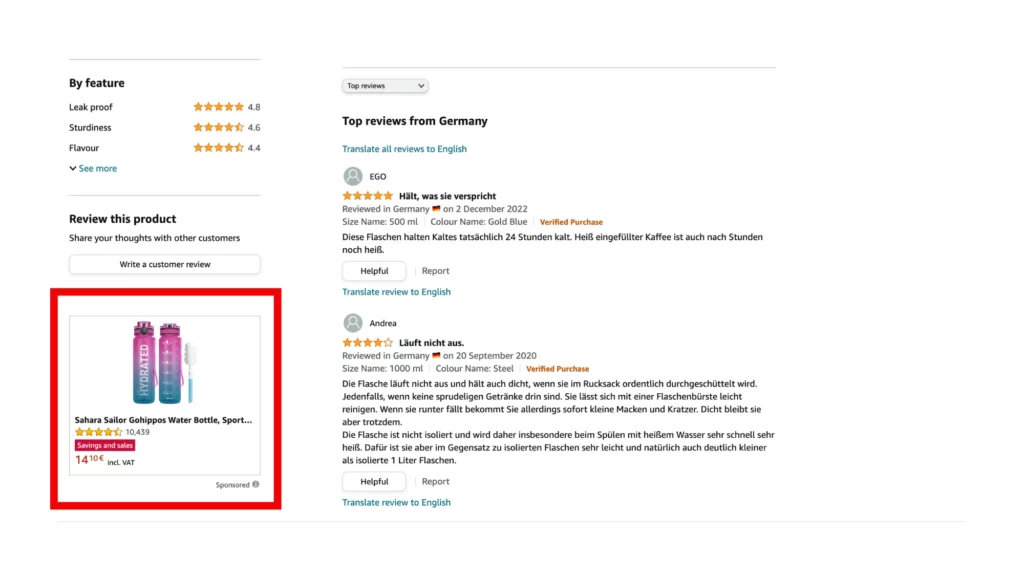
What type of users can you reach with Sponsored Display campaigns?
With Sponsored Display campaign type you can align the ads with interests, categories, products or user behavior.
This is how you can reach users who have:
- Clicked on your product but didn’t buy it
- Bought a similar product
What are the targeting options for Sponsored Display campaigns?
Sponsored Display campaign type you have two targeting options:
- Product targeting
- Sponsored Display audiences
With product targeting, you can display your ads for specific products or selected product categories.
With Sponsored Display audiences, you can reach the people who viewed your products, related products, relevant categories, and even categories with products not on Amazon.
- In-market audiences (people who have recently purchased products from a certain category),
- Lifestyle audiences (people with shopping activities that match a specific lifestyle interest, such as sports enthusiasts or tech fans)
- Interest-based audiences
What are the benefits of Sponsored Display campaigns?
The biggest benefit of Sponsored Display campaigns is active remarketing or retargeting. You can’t do that with other Amazon ad campaigns.
What are the disadvantages of Sponsored Display Ads?
Advertising to users outside of the Amazon environment can also be a downside. Users might not be in the right mood to open their wallets and buy your products.
Key Takeaway
You can choose between 3 campaign types to promote your products: Sponsored Products, Sponsored Brands and Sponsored Display.
- If you want to increase your product visibility, choose Sponsored Products.
- If you want to build your brand awareness, go with Sponsored Brands.
- And if you want to reach audiences interested in products similar to yours, pick Sponsored Display (those are shown on and off Amazon!).
They don’t exclude each other: you can have multiple campaign types in your Amazon advertising account.
Regardless of which campaign type you go with, keep running ads for some time before making any changes. Start with feeling your way with bids, keyword options and keyword selection.
In any case, keep track of the results and then continue with PPC optimization.
Set Up Powerful Sponsored Products Ad Campaign in 9 Steps
It is no secret that Amazon Advertising is the key that can unlock sales growth.
But here’s the deal: campaigns with a random set up are not going to skyrocket your sales numbers.
So here is a 9-step tutorial on how to create a Sponsored Products ad campaign that can boost your sales:
1. Log in to your Seller Central account (or Vendor)
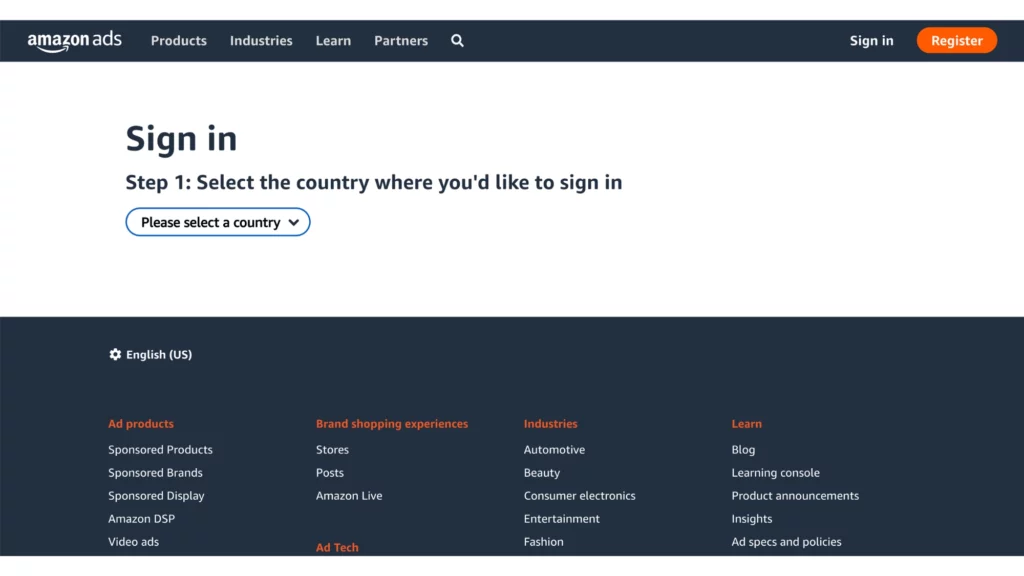
2. Create Campaign
In your Seller Central account (or Vendor), find the “Advertising” tab. Then click on “Create campaign“.
3. Select Campaign type
- Sponsored Products
- Sponsored Brands
- Sponsored Display
4. Name your campaign
Name your campaign in a way that you can immediately tell what it is about. The best practice for campaign naming is to use the product brand or product category name.
In this way you will create a great base for an organized campaign structure.
Trust me, you will thank yourself later when your advertising grows and you will manage tens or even hundreds of campaigns!
You can also create a campaign portfolio that contains several campaigns. This is useful if you want to use different campaigns at the same time for a specific season.
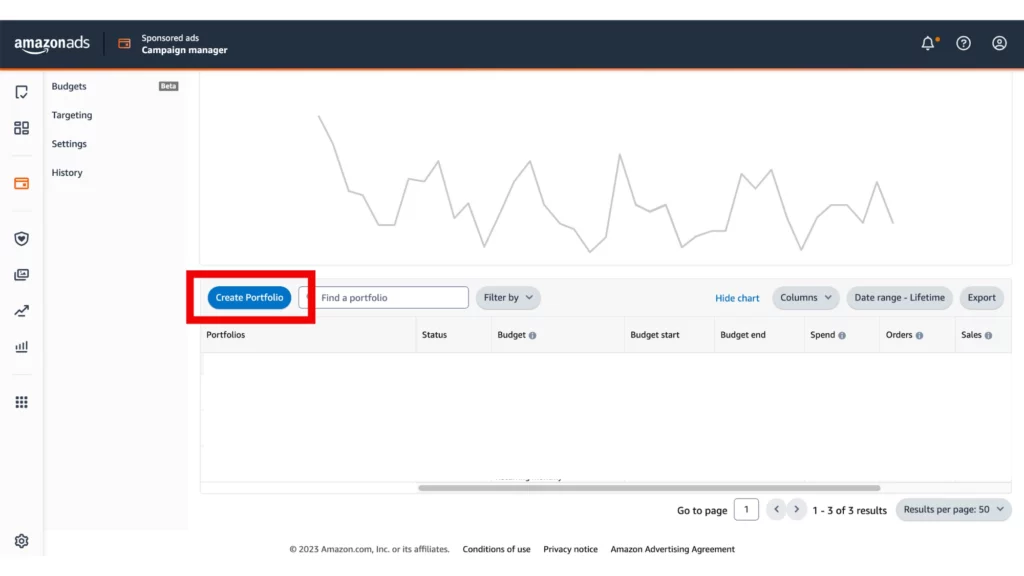
5. Set a campaign start and end date
For seasonal campaigns, this ensures that you do not waste any budget over the set period. For example, you probably don’t want to advertise Christmas products in January, right?
If you want to advertise long-term, simply leave out the end date.
6. Define a daily budget
The daily budget specifies the maximum amount that you want to spend per day on your ad campaigns. If you set the budget to 50€, a maximum of 50€ will be invested in your advertising campaigns per day.
You can set your daily budget as low as 1€. But I don’t recommend it. In most cases the 1€ budget will be exhausted way before the end of the day and you can consider it as wasted ad spend.
And once your daily budget runs out, your ads stop showing. No ads mean missed sales opportunities. So try to set a more realistic daily budget that is more likely to bring you positive results.
Important: Daily budget is an average value. On some days the advertising cost can be a bit above or below the set value.
Don’t worry, this doesn’t mean things will get out of hand and you will end up spending more than what you specified. Amazon’s advertising system calculates the daily spend based on your daily budget and estimated monthly spend.
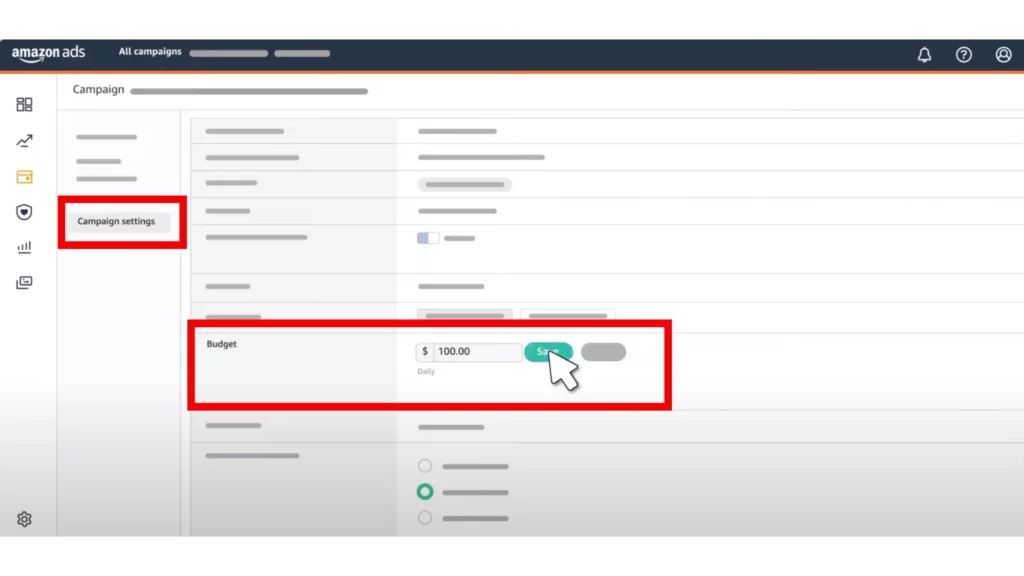
So: at the end of the month, your total sum should correspond to set daily budget. Even though on some days your advertising campaigns spent a bit more or less.
7. Automatic and Manual Campaigns – What Is Better?
After the initial set up of your Sponsored Products campaign, you need to decide: will it be automatic or manual?
Automatic campaign
With automated targeting, ads automatically create a keyword set based on your product descriptions. This keyword list is then used for advertising your selected products.
This is why automatic campaigns are useful at the beginning. You can see which new keywords bring you the most clicks. And more importantly, conversions that generate sales. In a way it works like a keyword research.
However, keyword control for ad serving is limited because you can only add negative keywords.
After you figure out which are your high performing keywords, I recommend you to either switch from automatic to manual campaigns or use an Amazon PPC software.
Manual campaign
Manual campaigns with manual targeting have more keywords options and you can choose each keyword yourself. You can also target individual products, ASINs and categories.
You can really get into the nitty gritty and create highly customized campaigns that will generate more conversions.
The question remains, do you have the time and skills to do all that? Alternatively, you can use a PPC software. It can free up a lot of your time that you would otherwise spend setting bids, doing keyword research, adjusting budgets, calculating ad profitability and whatnot.
8. Create ad groups
Whew, your campaign is set up! The next step is to create ad groups.
Put similar products into an ad group or groups and assign them suitable keywords.
9. How to Set Bids: Dynamic Bidding vs Fixed Bidding
To finish setting up your Sponsored Products ad campaign you need to decide on a bidding system. You can go for dynamic bidding or fixed bidding.
Dynamic bidding
Most Amazon sellers and vendors go for dynamic bidding. Why? Because it is partially automatic.
You only set a maximum CPC bid (Cost Per Click) and Amazon Ads will do the rest. The platform can either decrease or increase bids based on the current demand, but it will never bid more than your specified maximum CPC bid.
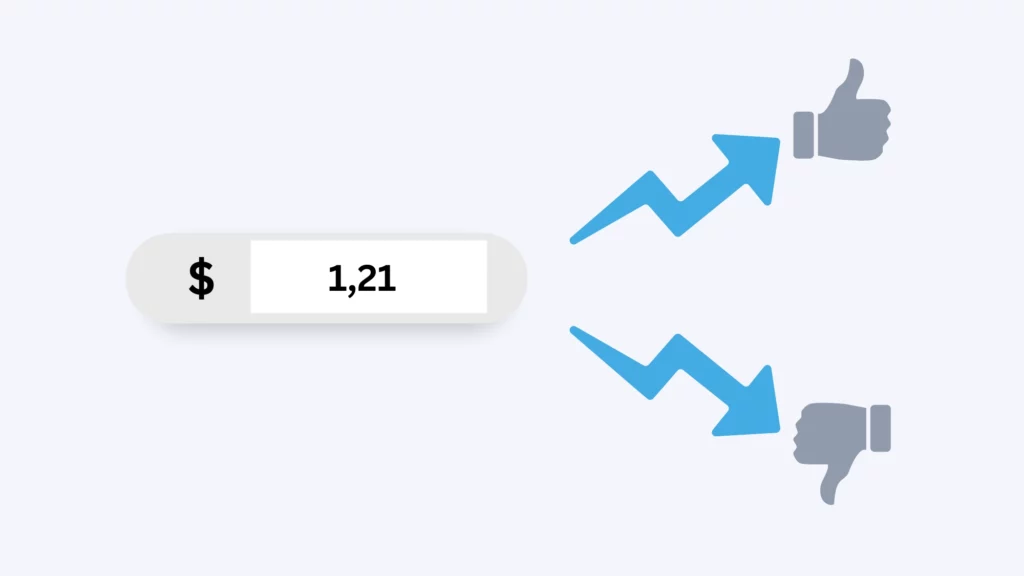
Upside: it’s a true time-saver
Downside: it might not be the most profitable option
Fixed bidding
Fixed bidding means that you need to set bids for every single keyword in your advertising campaign. But here’s the kicker: it is not a one-off task.
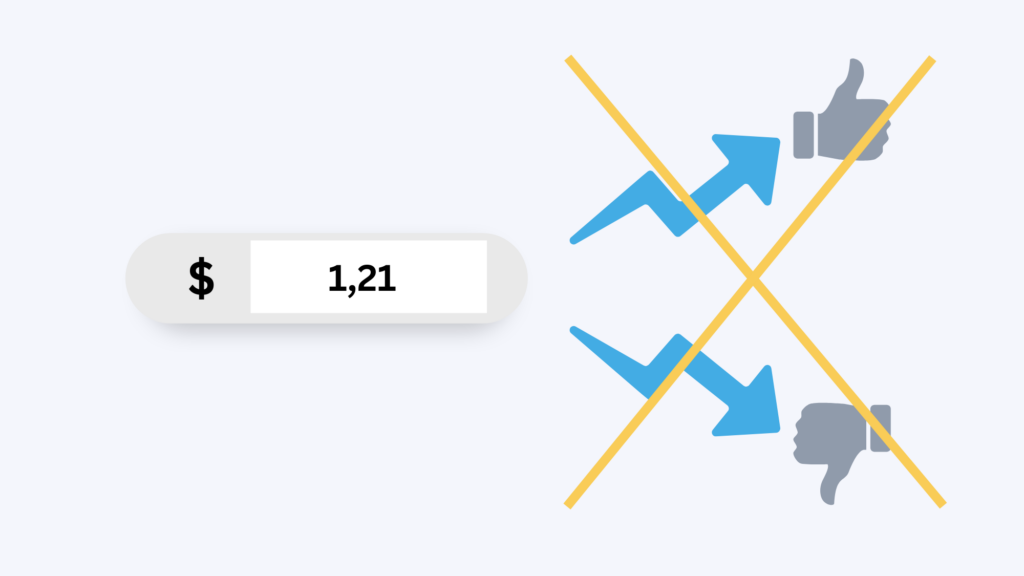
You need to keep evaluating and adjusting your bids for your ads to perform well. Which is great if your campaign is small and you have the time and know what you are doing.
But if you don’t have the time not skill, you might want to consider getting help from an expert, Amazon agency or an optimization tool.
Key Takeaway
Sponsored Products campaign type is the go-to campaign for most sellers and vendors.
To make every cent count, it is important you set it up correctly right from the start. And congrats, if you followed the 9 steps above, you made it!
What is next?
Optimization of your PPC campaigns. Yes, you should let your newly set up campaign run as it is for a few days.
But sooner or later you need to check the results, evaluate the data and continue with tweaks and adjustments. Optimizing your PPC campaigns is the only way to get the most out of your invested advertising budget.
Let’s dive right in!
Amazon PPC Optimization Checklist
6 Best Practices for Most Profitable Ads
1. Measure Your Success With Amazon Advertising Metrics
How do I optimize my Amazon ads? First step in the optimization is measuring the success of your advertising campaigns.
You can do that by following Amazon advertising metrics. A lot of people use the expression KPI – key performance indicators.
Based on the metrics you won’t be left in the dark and you can make informed decisions on how to optimize Amazon PPC campaigns.
Here’s a list of Amazon pay-per-click KPIs:
- ACoS – Advertising Cost of Sale
- Clicks
- Conversions
- Conversion Rate
- Conversion Value
- COGS – Cost of Goods Sold
- Impressions
- CPC – Cost per Click
- CPM – Cost per Mile
- CPO – Cost per Order
- CTR – Click Through Rate
- ROAS – Return on Ad Spend
ACoS
The Advertising Cost of Sales (ACoS for short) indicates the relationship between your advertising costs and sales. ACoS is a great metric because it quickly gives you an idea how profitable are your campaigns.
It is calculated like this:
ACoS = (your total Amazon ad spend / your revenue from clicks on your ads) x 100
Practical Example
You advertise a product for 10€ (this is your ad spend). Your revenue from clicks on your ads is 1000€. Your ACoS is 1%.
This means that your ad spend is 1€ for every 100€ revenue. In other words, you are investing 1% of your sales in advertising.
The higher the ACoS, the more you spend on advertising. Which of course affects your profit margin. Your goal is to have as low target ACoS as possible.
My advice: don’t start spending money and then see how much you are willing to spend on advertising.
Rather first check your costs, sales, profits and other relevant factors. And then decide how much does it make sense for you to spend on advertising.
Then you can work on optimizing your Amazon PPC ads towards your target ACoS.
Clicks
The number of clicks tell you how many people clicked on your ad.
Don’t worry about invalid clicks or accidental clicks. Amazon filters them out within 3 days and you don’t need to pay for those.
Conversions
A conversion means that after someone clicked your ad, they also bought your product.
Conversion Rate
Conversion rate is the ratio between the number of clicks and purchases. It is expressed as a percentage. A conversion rate of 5% means that 5 out of 100 clicks resulted in a purchase.
The higher the conversion rate, the better!
Conversion Delay
Conversion delay describes the period of time in days until a purchase can be clearly assigned to a click.
It is common for pricier products when shoppers take more time to decide if they are going to buy it or not. Amazon ads display a conversion delay of up to 14 days.
When measuring the success of your advertising activities, don’t forget about conversion delay!
Practical Example
You see that on Monday you sold 10 products. But these sales are actually a consequence of an ad click that happened 4 days ago.
In this case the conversion delay for those 10 products was 4 days.
Conversion Values
Conversion value is the monetary value assigned to a desired action, such as a purchase or add-to-cart, that occurs as a result of your Amazon campaign.
Cost of Goods Sold (COGS)
COGS refers to the costs associated with the production of a product that has been sold. These costs include expenses such as materials, labor, and shipping. However, costs for storage and delivery are deducted from this amount.
CPC – Cost per Click
CPC stands for “Cost per Click” and shows you how much you paid per click on one of your ads.
CPM – Cost per Mile
The abbreviation stands for “cost per mille”. The metric tells you how much 1000 impressions cost you. CPM is calculated with the total number of your impressions divided by ad spend.
CPM = (Total Cost ÷ Total Number of Impressions) x 1000
CPO – Cost per Order
Cost per order (CPO in short) shows the relationship between advertising costs and orders. For this purpose, all advertising costs are set in relation to the orders.
In contrast to the ACoS, the CPO is a more comprehensive KPI that includes all costs.
CTR – Click Through Rate
Click through rate indicates the ratio of impressions and actual clicks in percentages. If your ad is shown 100 times and 1 user clicks on it, your CTR is 1%.
Impressions
Impressions indicate how often your ad was shown. If you want to increase your brand awareness, then you should track the number of impressions.
ROAS – Return On Ad Spend
Return On Ad Spend (short: ROAS) is one of the key metrics used in Amazon advertising to measure the effectiveness of PPC campaigns. It helps you understand the profitability of your campaigns.
A high ROAS indicates that a campaign is generating more revenue than it costs to run, while a low ROAS indicates the opposite.
ROAS is calculated by dividing the total revenue generated by an ad campaign by the total amount spent on that campaign and multiplying the result by 100.
For example, if you spend 500€ on an Amazon ad in a month and your advertising campaign generated revenue of 2000€, your ROAS is 400% (2000€ / 500€ * 100 = 400% ROAS). You can also calculate your ROAS factor to determine how much revenue you made with every invested cent. To do so, you simply divide the total revenue by the total amount spent. In our example, this means 2000€ ÷ 500€ = 4. This means you made 4€ in sales by investing 1€ in advertising.
These are the basic Amazon advertising metrics every Amazon seller or vendor should know about. There’s much more to Amazon lingo, acronyms and other metrics.
Don’t let that overwhelm you. Follow these Amazon PPC tips for optimization and you will do fine!
2. Optimize your product details page
The quality of your product detail page with text and images plays an important role in your campaign performance.
You did your homework and built a retail ready product details page? Good!
But here’s the catch: your work isn’t finished. Now it is time to polish your product listings to the (more or less) final form.
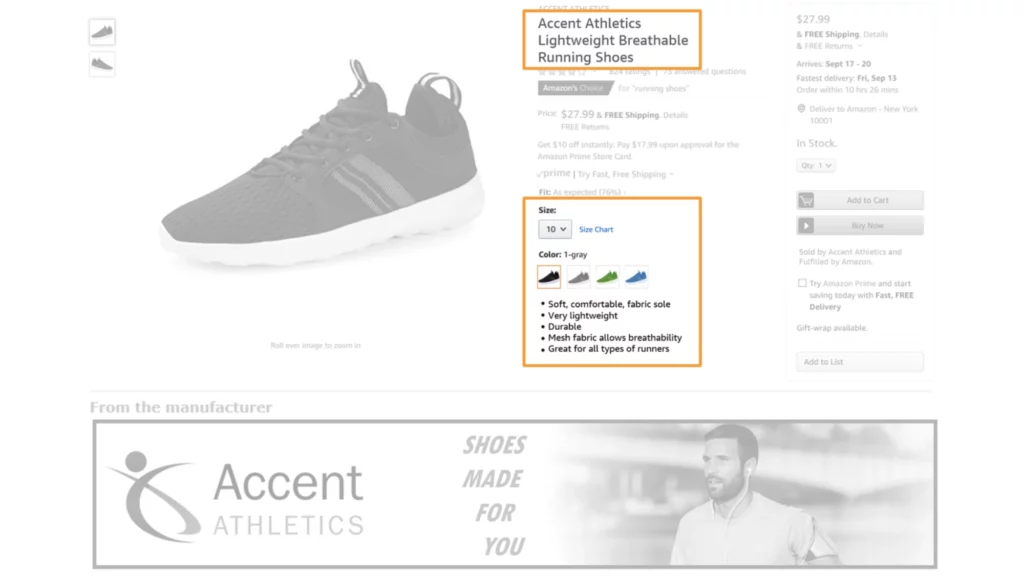
There’s always something your can do to:
- Reduce your bounce rate
- Increase the chances of conversions
How? Regularly update your content:
- Add new images
- Update product description
- Add high performing keywords
3. Categorize your products
I don’t mean Amazon categories. I mean divide your product portfolio in categories that give you a quick overview of your inventory.
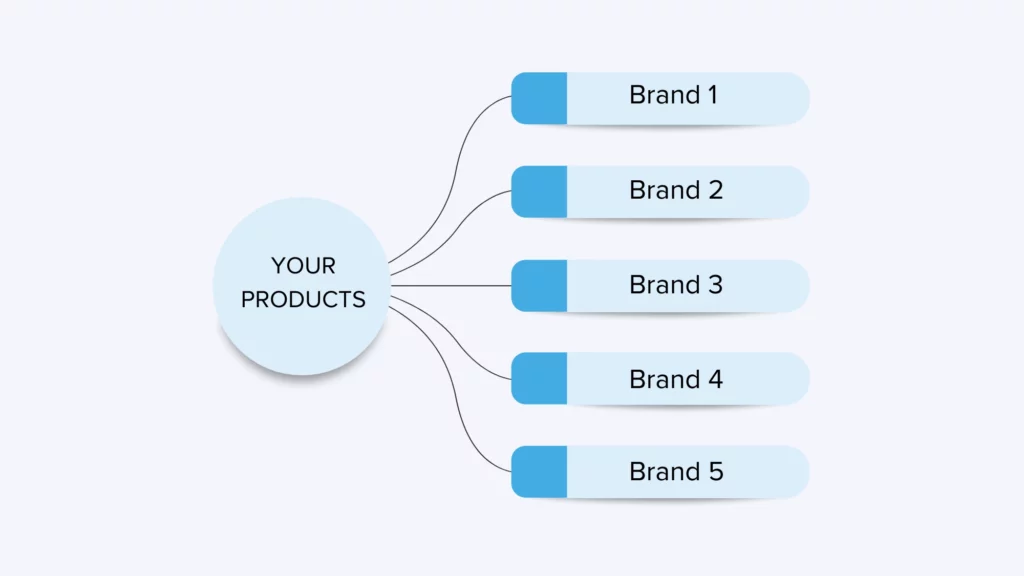
You probably don’t sell only one kind of product and this will help you stay organized. But if you do, feel free to skip this step.
Your key categories could be:
- Top selling products (products that generate most of your sales)
- Individual brands (for example: New Balance, Fila, Nike, etc.)
- Product categories (for example: phone cases, key chains, scarves)
- Seasonal products
This can help you decide on your Amazon PPC campaign structure, see which seasonal products you could promote next and keep an eye on your top sellers.
4. Choose a suitable Amazon ad campaign structure and adjust it
The campaign structure is the backbone of your PPC campaigns. The structure that reflects your goals and needs will result in more profitable ads. As long as you stay consistent!
A big part of Amazon campaign optimization is recognizing how to group your products in advertising campaigns in the optimal way.
Ad Campaigns for Top Sellers
Top sellers are your money makers. If there’s a clear demand, then why wouldn’t you sell even more?
Investing in PPC advertising of your top sellers is usually one of the safest ways to grow sales.
Run your numbers and decide how much you would like to invest in advertising.
Create a separate ad campaign for each top selling product in your portfolio and watch your traffic and sales grow!
5. Keywords are Core of Amazon PPC Management
Whatever you do, don’t start advertising on Amazon and then forget about it. Tracking your campaign performance and then optimizing your ads is crucial!
The heart of PPC management and optimization are keywords (and ASINs). Revise them on a regular basis and repeat keyword research.
Through the Amazon Ads platform you can access Amazon Search Term report. The Search Term report includes the entire list of keywords used to trigger your ads including the information about their performance.
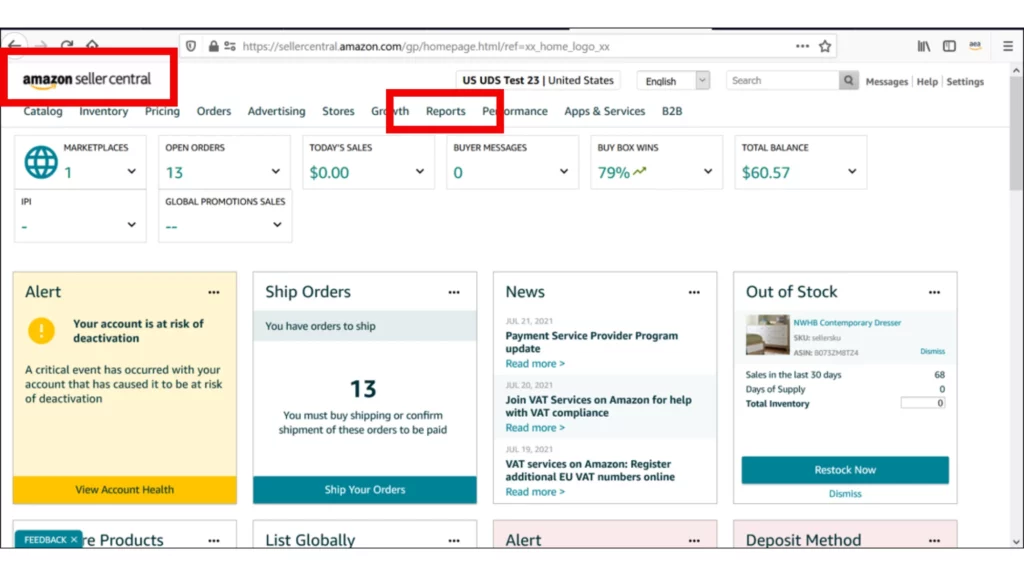
Use Auto Campaign to Find Winning Keywords
Work smarter, not harder and let automatic campaigns automatically create your keyword lists.
Set up a Sponsored Products campaign and let it run for a while so it gathers enough data about which keywords work better than others.
This is how you can gracefully skip compiling keywords lists on your own and save yourself some precious time and advertising efforts.
But after your Amazon ad campaigns have been running for a while, it’s time to roll up your sleeves.
Analyze all keywords and extract:
- Keywords that bring in most of conversions
- Long-tail keywords
- Negative keywords
Step 2 is to level up your PPC game and switch from automatic to manual campaigns. Here is how:
Use Manual Campaigns to Maximize Results
At this point you should have gathered the best-performing keywords.

Now: create manual campaigns to get the most profit out of your advertising campaigns. When you use manual campaigns, your hands are more free and can use more keywords options and adjustments.
Besides well-converting keywords you should include long-tail keywords to your manual campaigns. Yes, I know – longtail keywords can be more expensive.
But if you ask me, they are worth it because they tend to have better conversion rates! So go ahead and add them to your list.
Last step in Amazon PPC management: negative keywords. Here, I strongly recommend you to use caution. Adding a negative keyword will exclude it from the campaign.
Only add those negative keywords that are completely wrong and you are 100% sure you cannot benefit from them.
6. How to Optimize Without Losing Time
All the tips I listed so far are great. But they all share one big disadvantage.
They all take time! Conditions are constantly changing, new, trending keywords keep appearing, you have to regularly adjust bids not to waste ad budget, analyze your data, read the reports and so on.
How often should you optimize Amazon ads? Ideally, every day!
Optimizing your ads can quickly start eating away your time that you would usually spend to update your product details, grow your portfolio, talk with suppliers, prepare shipments etc.
That said, you can save a tremendous amount of time by using an Amazon PPC software to drive your Amazon Ads.
Top Tip: Use PPC Optimization AI
Consider an everyday chore–like doing laundry, for example. Each time you gather your clothes and fold, it’s the same task.
Imagine how satisfying it’d be if, after dumping your clothes in the dryer, they came out perfectly folded?
That’s basically what you get with an optimization AI. AI can analyze thousands of data points and find the best settings for your PPC campaigns and sets bids in split seconds.
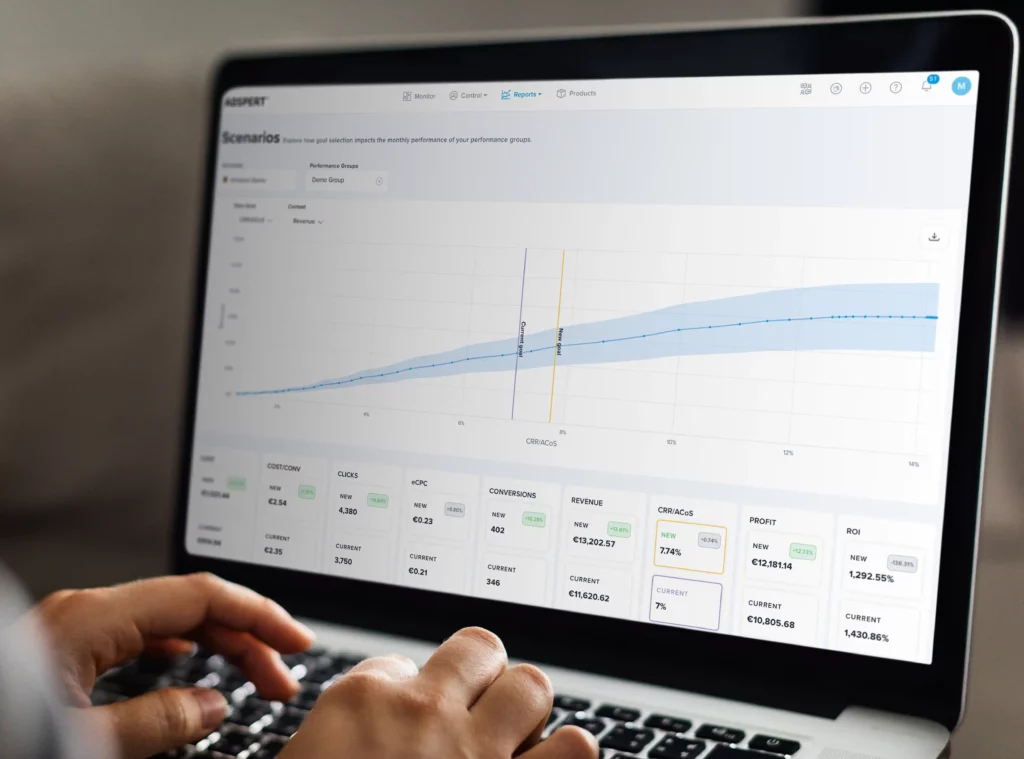
5 Benefits of PPC Optimization Tools
Optimization tool can then save you a lot of work by automating processes and increasing and securing the performance of your campaigns.
- Optimizes 24/7
- Saves you time and money
- Sets most efficient bids
- Performs keyword harvesting and suggests keywords, ASINs and PATs
- Effectively allocates your PPC advertising budget
PPC Bid Management With Algorithmic Bidding
There are many Amazon PPC optimization tools out there. One main difference is the bidding systems: some use rule-based bidding and others employ algorithmic bidding.
I admit, I am a bit biased here because algorithmic bidding is the core of our PPC optimization AI tool.
But that’s not the only reason why I am a part of the “algo” team. An algorithm can achieve your results faster than any human.
Al can:
- Look at the whole picture, all available historical data
- Use data from previous campaigns, similar products/ads/keywords,
- Takes in the account other parameters from your ad account
- Take appropriate action on your behalf
- Make sure your keywords aren’t competing with each other
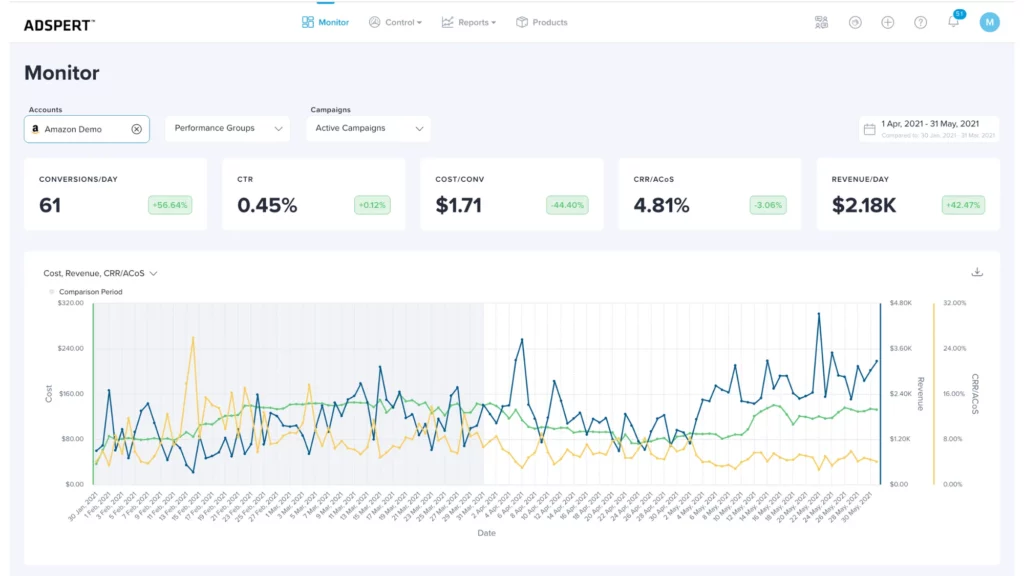
Let’s get more specific.
I’ll use Adspert, our smart AI as an example to demonstrate how AI can boost your PPC campaigns.
- Adspert analyzes all your account parameters and other Amazon data around the clock
- Models the market
- Recognizes keywords and ASINs that perform well and poorly
- Uses algorithms to set the most efficient bids for you
- Harvests and suggests promising keywords and ASINs
- Automatically adds them to your campaigns (if you want to)
How to Reach Your Advertising Goals Without Breaking a Sweat
Amazon PPC software usually includes the option to set a campaign goal.
First, choose your business objective:
- More reach
- More sales
- Budget optimization
Second, choose a suitable goal in your Amazon PPC tool. With Adspert, you can choose between:
- Cost per day
- Cost per conversion
- CRR / ACoS (Advertising Cost of Sales)
- ROAS (Return On Ad Spend)
- ROI (Return On Investment)
- Profit Maximization
Third, define your goal value that you would like to reach, for example 15% ACoS.
Finally, you can kick back, relax and let the PPC optimization AI take the wheel.
Key Takeaway
In a nutshell, using a PPC Optimization AI can save you a lot of time and effort. It does not take the human factor completely out of the equation, but it does free up your resources and saves your nerves.
There’s a lot of PPC tools out there. If you would like to try Adspert, you can start FREE 30-day trial now, no strings attached. Or read this article to learn more how Adspert nails PPC bid optimization.
Final Words
So, that’s my ultimate guide to Amazon PPC optimization.
We first covered the basics and learned Amazon PPC stands for pay-per-click advertising. Even if you are not a complete digital marketing rookie, Amazon Ads can be confusing because there are so many options and functionalities.
In this practical guide I laid out what is important within Amazon Ads, which campaigns you can run and what you should pay attention to when setting them up.
More than that, I presented tips and tricks for optimization. I also explained how PPC tool can help you save time and money.
Which approach from this guide do you want to try first? Or maybe you found a useful tip you would like to share with your friends or colleagues?
Share it on your social media channel and please tag Adspert!



